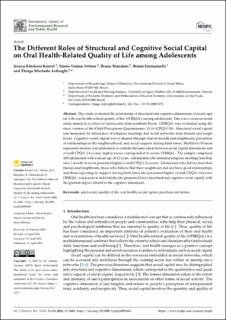| dc.contributor.author | Knorst, Jessica Klöckner | |
| dc.contributor.author | Vettore, Mario Vianna | |
| dc.contributor.author | Brondani, Bruna | |
| dc.contributor.author | Emmanuelli, Bruno | |
| dc.contributor.author | Ardenghi, Thiago Machado | |
| dc.date.accessioned | 2023-05-02T09:02:59Z | |
| dc.date.available | 2023-05-02T09:02:59Z | |
| dc.date.created | 2023-04-21T08:39:41Z | |
| dc.date.issued | 2023 | |
| dc.identifier.citation | Knorst, J. K., Vettore, M. V., Brondani, B., Emmanuelli, B. & Ardenghi, T. M. (2023). The Different Roles of Structural and Cognitive Social Capital on Oral Health-Related Quality of Life among Adolescents. International Journal of Environmental Research and Public Health, 20(8), 1-10. doi: | en_US |
| dc.identifier.issn | 1661-7827 | |
| dc.identifier.uri | https://hdl.handle.net/11250/3065699 | |
| dc.description.abstract | This study evaluated the relationship of structural and cognitive dimensions of social capital with oral health-related quality of life (OHRQoL) among adolescents. This was a cross-sectional
study nested in a cohort of adolescents from southern Brazil. OHRQoL was evaluated using the
short version of the Child Perceptions Questionnaire 11-14 (CPQ11-14). Structural social capital
was measured by attendance of religious meetings and social networks from friends and neighbours. Cognitive social capital was evaluated through trust in friends and neighbours, perception
of relationships in the neighbourhood, and social support during hard times. Multilevel Poisson
regression analysis was performed to estimate the association between social capital dimensions and
overall CPQ11-14 scores; higher scores corresponded to worse OHRQoL. The sample comprised
429 adolescents with a mean age of 12 years. Adolescents who attended religious meetings less than
once a month or never presented higher overall CPQ11-14 scores. Adolescents who did not trust their
friends and neighbours, those who believe that their neighbours did not have good relationships,
and those reporting no support during hard times also presented higher overall CPQ11-14 scores.
OHRQoL was poorer in individuals who presented lower structural and cognitive social capital, with
the greatest impact related to the cognitive dimension. | en_US |
| dc.language.iso | eng | en_US |
| dc.publisher | MDPI | en_US |
| dc.relation.uri | https://www.mdpi.com/1660-4601/20/8/5603/pdf | |
| dc.rights | Navngivelse 4.0 Internasjonal | * |
| dc.rights.uri | http://creativecommons.org/licenses/by/4.0/deed.no | * |
| dc.title | The Different Roles of Structural and Cognitive Social Capital on Oral Health-Related Quality of Life among Adolescents | en_US |
| dc.type | Peer reviewed | en_US |
| dc.type | Journal article | en_US |
| dc.description.version | publishedVersion | en_US |
| dc.rights.holder | © 2023 The Author(s) | en_US |
| dc.subject.nsi | VDP::Medisinske Fag: 700::Klinisk odontologiske fag: 830 | en_US |
| dc.source.pagenumber | 10 | en_US |
| dc.source.volume | 20 | en_US |
| dc.source.journal | International Journal of Environmental Research and Public Health | en_US |
| dc.source.issue | 8 | en_US |
| dc.identifier.doi | https://doi.org/10.3390/ijerph20085603 | |
| dc.identifier.cristin | 2142359 | |
| dc.source.articlenumber | 5603 | en_US |
| cristin.qualitycode | 1 | |

